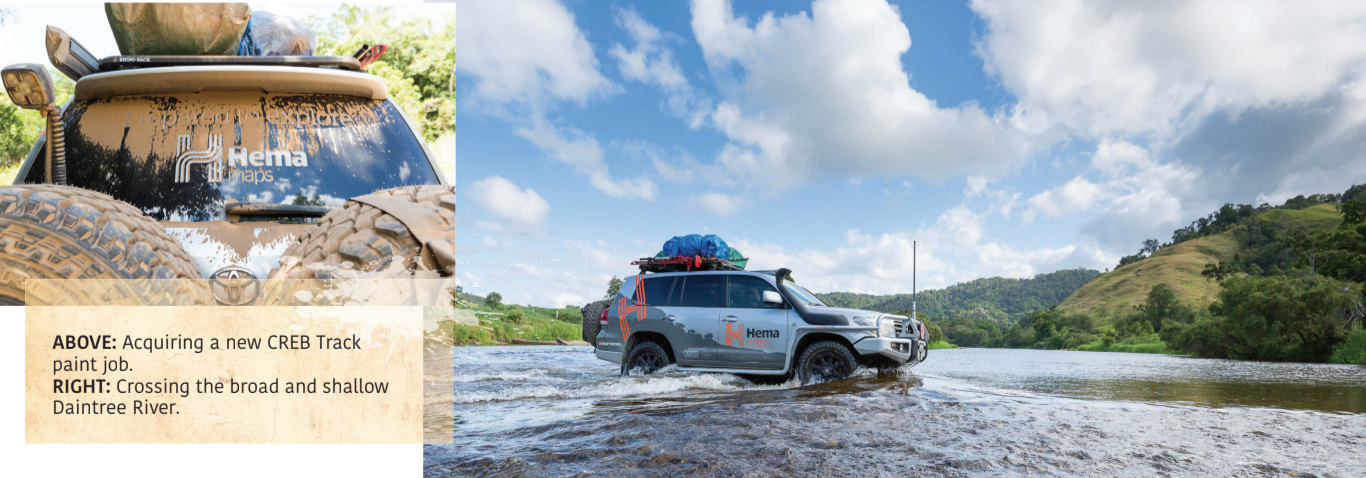4WD ADVENTURES TOP 100 - TRACK # 29 - CREB Track
GRADING: 4WD, Extreme.
TIME: Day trip or overnight.
DISTANCE: 132km, Cooktown to Daintree.
LONGEST DISTANCE WITHOUT FUEL: 82km, Wujal Wujal to Wonga Beach (towards Mossman).
BEST TIME OF YEAR Dry season: May to October. Don’t try it after any rain and always check with locals for the latest information before attempting.
WARNINGS: Even light rain can make some of the descents extremely dangerous – don’t drive on the track when it has been closed by the Council. The top of Roaring Meg Falls is a recognised women’s site for the Buru people, so signage asks men to not visit
the site. No alcohol is permitted in the Roaring Meg Falls area. Camping is only permitted in the designated zone; do not camp at the swimming area (beach) or beside the river’s edge. Alcohol restrictions also apply in Wujal Wujal.
PERMITS AND FEES: Visitors are asked to contact a representative of the Burungu Aboriginal Corporation (traditional owners) prior to accessing Roaring Meg Falls. Fees apply for camping.
MAPS: Hema’s Cape York.

THE DRIVE
Hidden by deep rainforest, the CREB Track’s red-clay surface and very steep angles mean that the slightest rainfall, even days old, can render the track nearly impassable.
Just over 60km long, it is one of the best, and most challenging 4WD trips in north Queensland. A brief drizzle mid- trip, not unlikely in this coastal rainforest, and going downhill becomes an exercise in careful braking and steering. Even mud tyres have a hard time with this stuff. In the old days, when this was the only road up the coast, everyone would fit chains to their tyres to cross this range. Now, the Douglas Shire Council closes the track for much of the year, warning that if you travel on a ‘closed road’, you’ll have to pay for your own rescue.
The Council does not recommend towing, but the careful driver, on a very dry day, can make it through unscathed, although not unnerved. It’s worth planning your trip carefully, because what looks like a two- or three–hour trip can actually become a
much longer drive if conditions are not optimal.
With World Heritage–listing, this area is particularly sensitive, and travellers should respect the land and stay on the Track. From Cooktown the Mulligan Hwy heads south until you get to the Helenvale turn, which takes you past the legendary Lions Den Hotel. About
33km later you arrive in Ayton. From here you can travel down the CREB Track, or the Bloomfi eld Track if the CREB is closed.
The first 15km or so of the CREB are relatively easy – a winding gravel road through the rainforest, with great views and waterfalls along the way. As you get into the heart of the McDowall Range, though, the Track shows its true colours. This continues until you drop out of the Range to the Daintree River, a broad shallow crossing, and find yourself in the sleepy town of Daintree.
HISTORY
Carved through the Daintree Rainforest by the Cairns Regional Electricity Board (CREB), the Track became obsolete when the Bloomfi eld Track was cut closer to the coast. It now operates solely as a recreational track and southern access to the Burungu land at China Camp.
For thousands of years, the Kuku Yalanji people have lived in this region. The path of the CREB Track mostly follows ancient Aboriginal foot trails. After Captain Cook and his crew took refuge in Cooktown in 1770, few white men visited for almost 100 years. Kennedy’s expedition in 1848 bypassed this section of coast, highlighting how difficult the terrain was, and still is. The 1873 discovery of gold in the Palmer River essentially built Cooktown and plenty more ghost settlements like Maytown, but the area around the CREB Track was primarily mined for tin.
BLOOMFIELD TRACK
While not as technically challenging as the CREB Track, the Bloomfi eld Track cuts through the same coastal rainforest, crossing numerous creeks and scaling some impossibly steep hills. Running from Cape Tribulation in the south to Wujal Wujal in the north, it is 4WD-only. However, it is much more forgiving than the CREB, with concrete on the steepest sections and graded gravel the rest of the way. The track is subject to seasonal fl ooding, slips, loss of traction, potholes and fallen trees.
Built in 1984 amid much controversy, this is the most direct route between Cairns and Cooktown. Incidentally, the uproar caused by the road’s construction led, eventually, to World Heritage–listing and a ban on logging four years later.
Facilities are available as far north as Cape Tribulation, and there is no camping along the Track. For information contact the Douglas
Shire Council Ph (07) 4099 9444,
www.douglas.qld.gov.au/road-
conditions/bloomfield-track.
